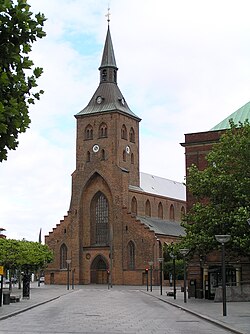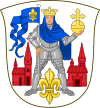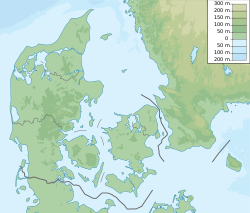Odense
| Odense | ||
|---|---|---|

|
||
|
||
| Location in Denmark | ||
| Coordinates: 55°23′45″N 10°23′19″E / 55.39583°N 10.38861°ECoordinates: 55°23′45″N 10°23′19″E / 55.39583°N 10.38861°E | ||
| Country | Denmark | |
| Region | Southern Denmark (Syddanmark) | |
| Municipality | Odense | |
| Established | 988 | |
| City charter | 1355 | |
| Municipality | 1970 | |
| Area | ||
| • Total | 304.34 km2 (117.51 sq mi) | |
| Elevation | 13 m (43 ft) | |
| Population (2016) | ||
| • Total | 175,245 | |
| • Density | 580/km2 (1,500/sq mi) | |
| • Municipal | 198,972 | |
| Time zone | CET (UTC+1) | |
| • Summer (DST) | CEST (UTC+2) | |
| Postal code | 5000–5270 | |
| Area code(s) | (+45) 6 | |
| Website | www.odense.dk | |
| Largest groups of foreign residents | |
| Nationality | Population (2014) |
|---|---|
|
|
2,712 |
|
|
2,707 |
|
|
2,397 |
|
|
2,164 |
|
|
2,155 |
|
|
1,668 |
|
|
1,577 |
|
|
1,162 |
|
|
1,107 |
|
|
937 |
|
|
740 |
Odense (Danish pronunciation: [ˈoðˀn̩sə]) is the third-largest city in Denmark. It has a population of 175,245 as of January 2016, and is the main city of the island of Funen. By road, Odense is located 45 kilometres (28 mi) north of Svendborg, 144 kilometres (89 mi) to the south of Aarhus and 167 kilometres (104 mi) to the southwest of Copenhagen. The city is the seat of Odense Municipality and was the seat of Odense County until 1970, and Funen County from 1970 until 1 January 2007, when Funen County became part of the Region of Southern Denmark. Odense has close associations with Hans Christian Andersen who is remembered above all for his fairy tales. He was born in the city in 1805 and spent his childhood years there.
There has been human settlement in the Odense area for over 4,000 years, although the name was not mentioned in writing until 988, and by 1070, it had already grown into a thriving city. Canute IV of Denmark, generally considered to be the last Viking king, was murdered by unruly peasants in Odense's St Alban's Priory on 10 July 1086. Although the city was burned in 1249 following a royal rivalry, it quickly recovered and flourished as a centre of commerce in the Middle Ages. After a period of decline, large-scale plans for development were made during the 18th century, which led to the rebuilding of Odense Palace and the building of a canal to the Port of Odense, facilitating trade. In 1865, one of the largest railway terminals in Denmark was built, further increasing the population and commerce, and by 1900, Odense had reached a population of 35,000. Odense's Odinstårnet was one of the tallest towers in Europe when built in 1935 but was destroyed by the Nazis during World War II. The University of Southern Denmark was established in 1966.
...
Wikipedia


